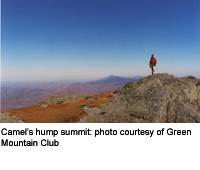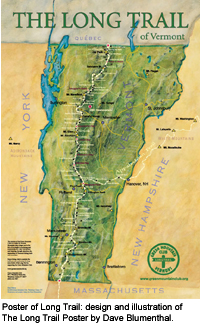Tales from the Trail -
Hiking through the Green Mountains Solo
By Mary Lou Recor

When I first told my mother that I planned to hike Vermont's 270-mile Long Trail by myself, her face took on that pained expression that mothers have perfected over the centuries, the one that says, "Why are you doing this to me?" She wasn't the only one to think I was putting myself at needless risk. A friend cautioned me with stories that ended "…and they never found her."
Every year, fewer than a half dozen women hike the Long Trail solo from Massachusetts to Quebec. What pushes them to leave their safety nets of friends and family, home and phone? What are their fears? What are their rewards?
Independence
For some women, the Long Trail is pure challenge, a chance to prove to themselves that they are physically and mentally strong. Others hike it to mark a significant birthday, like 30, 40, or 50. Still others have harbored this dream through years of crock pot meals, PTA meetings, and mortgage payments until they finally have time for themselves.
Sue Christiansen wanted to be more independent. She grew up in the 1950s and '60s, when women's career choices were more limited. She chose to become a nurse based on the advice of her guidance counselors; it was either teacher, nurse, or secretary. After she married, while raising children and making a home, she was restless. Once her children were grown, she joined the Peace Corps. On the flight home from her two-year adventure, she began thinking of the Long Trail. Although she had never backpacked, she went to a local outfitter to look at equipment and came away with comfortable boots and a pack. In 1998, she completed the Trail by herself in twenty-eight days. In 2002, she did it again. In 2004, she hiked the 2,170-mile Appalachian Trail. For Christiansen, long-distance hiking fulfills a need for an endurance challenge, hours of solitude, and the opportunity to cleanse her mind.

Freedom
Not all women who finish solo start out that way. Janet Steinert began with a friend who hurt her knee and had to leave the trail. Finding a compatible hiking companion can be as difficult as finding a life partner. A pairing that begins full of promise and enthusiasm can quickly deteriorate into drudgery. Not everyone can - or will - go the distance.
For Millie Mugica's first attempt to through-hike the Long Trail, she lined up friends and family members to join her all along the route. Unfortunately, some of her companions found that the adventure didn't live up to their expectations and went home early, leaving her alone for eight days. Having acquired a feel for the trail, Mugica decided it was easier to go solo. "There is more freedom when hiking alone - freedom to wake up and go when you are ready, freedom to take or not take breaks, or to explore side trails," she said. "Also, you are able to walk fast or slow depending on how you feel without regard to how another feels. There are times when I treasure the silence of solitude, especially in the morning or evening when the birds are singing and that's all I want to hear." Mugica has now hiked the Long Trail by herself six times.
Fear
In their hearts, women who set out on long-distance hikes know of the inherent dangers without needing to be reminded. Most of them take precautions for their own, and their families', peace of mind: they carry whistles and cell phones (though reception is spotty at best), take first-aid workshops, sign in at the trail registers, leave their itineraries with family members, call home when they can, and walk across slippery rocks with caution. They are smart, aware and careful. The two hazards they fear most are not snakes and bears but harassment and injury.
Like many women, Cathy Black was concerned about being in the woods so far from the reliably cellularized world. She didn't know what type of people she would meet, whether companions or creeps. Although she hiked the Trail without serious incident, she was spooked twice. At the tenting area on the south side of Bromley Mountain, she came upon a long-term squatter who had taken up residence there. Although he may have been harmless, her instinct told her to find another place to sleep. Further north, at Duck Brook Shelter near Jonesville, she encountered two men, obviously not through-hikers, who tried to frighten her by talking rudely and following her. She out-paced and out-distanced them. Black did not let those experiences deter her from further adventures. The benefits she receives from long-distance hiking outweigh the negatives to the point where the sport has become her main interest. In 2003-2004, she hiked the Appalachian Trail, alone.
Pain
According to a 2006 survey in Backpacker magazine, the most common cause of death in the outdoors is falling, followed by drowning, and heart attack. While the Long Trail has few precarious rock faces, the possibility of tripping over a root, a rock, or her own feet is very real to someone balancing 25-35 pounds on her back for 270 rough miles of rain, heat, cold, mosquitoes, hunger, and dog-tiredness. While pre-trip planning and physical conditioning can lessen the probability of injury, they cannot prepare her for that slippery root that she doesn't see or that stone that rolls her ankle beyond its normal range of motion.
Nancy Pejouhy had a close call on Mount Abraham, north of Lincoln Gap. As often happens in July in Vermont, the weather was chilly and rainy. She had seen few hikers all day. Her rain jacket had soaked through and she was damp. Miserable. On a narrow strip of trail, she slipped, falling backward into an evergreen. As she flailed like a turtle on its back trying to flip over, she realized how vulnerable she was. The thought that she could have sprained her ankle or broken her leg gave her pause to question the wisdom of hiking without company. But she righted herself and walked the last few miles to a shelter for the night. It took her thirty-five days to hike the Trail.
Loneliness
While the Long Trail can be a weeks-long social gathering full of chance meetings and traded stories, it can also be the "long and lonely" trail, especially once it departs from the Appalachian Trail north of Killington Peak. Depending on the day of the week, the time of year, and the remoteness of the trail section, it is possible to not see or talk with another human for three or four days. With no one to share the misery, minor annoyances can fester like poison ivy.
Lisa Price found that hiking alone for three weeks was more than she had bargained for. By the time she climbed Camel's Hump, she had spent several nights in shelters with only the mice for company. That, combined with hot, humid weather, limited views, losing her way, and battling stinging nettles convinced her that she was no longer enjoying the journey. For Price, "the loneliness just got the best of me." With two-thirds of the trail behind her, she made the tough decision to go home. Being away from friends and family taught her how important they are to her. The following year, she returned with a friend to finish the northern third.
Change
While solo long-distance hiking is not for every woman, those who complete the Long Trail talk about how the experience changed their lives. They report that they are more self-confident, less judgmental, more compassionate, more aware of nature, and more thankful for family and friends. They "stand taller." They have no regrets.
When Bonnie Bashaw-Cole started her hike, she had lots of emotional support from family and friends, especially her husband who believed in her even when she had doubts. She worried that she wouldn't be able to take care of herself if she were hurt. Once on the Trail, she had difficult times, losing her way in the rain and, more than once, thinking she would never make her destination for the night. But those could not overshadow the joy of watching the sun rise from the top of Bromley Mountain or traversing the summit ridge of Mount Mansfield on a clear day. Or sharing her birthday celebration with two fellow travelers at Watson Camp on Sterling Pond near Smugglers' Notch. As Bashaw-Cole said, "Hiking the Long Trail from end to end was the best experience of my life. It far surpassed my expectations. Every day was an adventure; some days [were] better than others but every day I learned something new. I was excited to wake up each morning and start walking." Not a bad way to live.
Reprise
I decided to solo the Long Trail for many reasons: I hoped to conquer my anxiety over sleeping out in a tent by myself; I wanted to prove I had the courage to do it; I couldn't find a companion whose schedule fit with mine. All reasons my non-hiking mother could not understand. Before I left for the trail, she and I made a deal: I promised to call her once a week and she promised to worry less. I kept my part of the bargain.
For more information on the Long Trail and hiking in Vermont, contact the Green Mountain Club at www.greenmountainclub.org or 802-244-7037.
Mary Lou Recor is a freelance writer, currently hiking the Pacific Coast Trail. She has authored numerous guides to hiking.
|

